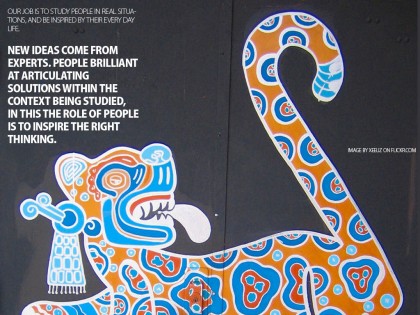Digital is not about technology, it’s about people and the situation their in. Finding brilliant solutions is all about studying these situations and discovering the contexts where companies can contribute, ad value, create meaning and become indispensable.

Steve Cunningham reminded me in a comment to one of my last posts that I was falling into my own trap (not his words, but mine :o) in regards to the fact that I was trying to limit Twitter to conversations, when in fact people should be allowed to use it any way they please.
- This should be obvious to me, as I use my own Twitter account not for conversation, but as a feed from this blog and an inspirational desk drawer I update. But, in the heat of battle i obviously slipped up a bit…
So I wanted to take a step back and give a bigger view on my take on technology, people and situations.
First, the short history of developing technological solutions, a combination of thoughts from amongst others Jeffery Veen, Indi Young, Robert Hoekman, Mark Earls and Donald Norman:
- – In the beginning of technology, we asked ourselves what can technology do? And then we built it, long lists of it, presented it to the customers and they found some of it interesting and useful, and a lot of it not.
– Then we started talking about users, these soulless mouse button clickers who have no ambition, motivation or context. We started asking people to envision what they thought they needed in constructed situations, the result being even longer lists of stuff that might be important to some people, but a lot of it not.
– So eventually we started thinking about situation, and a bigger picture outside of technology and “users”. We started saying that peoples anticipation, motivations and desires arise from the context they find themselves in. At the same time our/companies ability to ad value into this context is entirely dependent on our understanding of the situation as a whole and finding our role in it – and of course exploring new ways to make the situation even more valuable to the people and participants
Golf 4-5 viagra Walking one mile in 20 minutes.
.
– Finally other people have been added to the equation, as an individual is the product of the ideas of their community, and can not be seen in isolation. They think and act as a result of their interactions with others.
So this is why I think saying it’s about people is a bit to narrow, it’s about context and culture, it’s about situation.
And this is why I’ve been trying to write some stuff on Situation Marketing. Where the goal is not to do stuff because technology can, or produce stuff because the people we ask say it would be a good idea. Our job is to study people in real situations, and be inspired by their every day life. It sounds a bit elitist, but I believe new ideas come from experts. People brilliant at articulating solutions within the context being studied, in this the role of people is to inspire the right thinking.
– Both Malcolm Gladwell at PopTech and Donald Norman in Emotional Design: Why We Love (or Hate) Everyday Things point this out, saying that asking non-experts to articulate their understanding of an object or situation leaves them to become conservative and articulate solutions they later on will be unhappy with.
To sum it up:
It’s about situations. We need to explore these situations in order to identify which contexts companies can add value and where they can make a difference
. And then, by understanding people and technology, choose the appropriate tool to achieve the goal.
And an extra thanks to Steve for the heads up :o)
